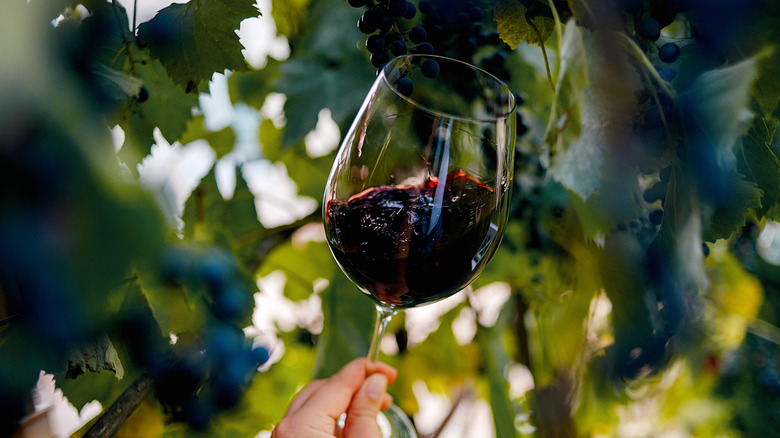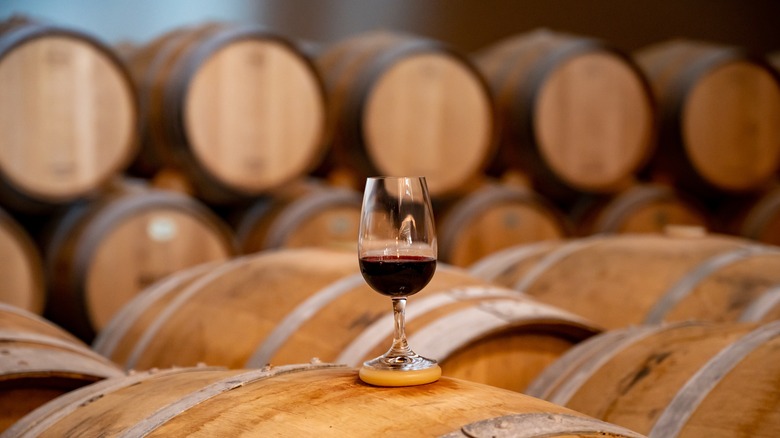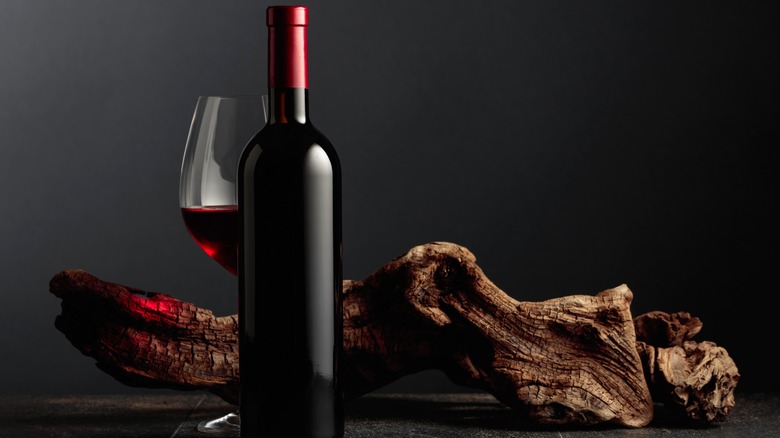These Are The Sweetest And Driest Red Wines You Can Drink
Enter a wine shop or explore the selection at a large grocery store and the red vino varieties can feel endless. With thousands of grape types used, knowing the difference between styles like Cabernet franc and Cabernet sauvignon is just the tip of the iceberg. In addition to varietals, there are the distinct ways grapes from different locations taste, as well as winemaker-constructed blends to consider. (Many of which are often the best red wines available under $30.)
So needless to say, red wine can take on a broad range of flavors, traditionally offering a mix of acid, dryness, fruit flavors, and perhaps some spicy or earthy notes. So it begs a fascinating question — among the many options, what are the most extreme-tasting bottles? After all, there is bound to be a wine out there with the most dryness, and conversely, the greatest amount of sweetness.
As it so often goes with such complex beverages, there's no direct answer, but rather a few candidates to consider. And the wine industry's residual sugar scale is an excellent starting point. This measurement notes the amount of sugar per liter in a bottle after fermentation is complete. So examining the highs and lows of this scale — fortified wines on the sweet end and Nebbiolos on the dry — is a good initial guess, but there's also lots more to unpack.
Fortified wines and other select styles are the sweetest red wines
Based on the residual sugar scale, wines with over 30 grams of sugar per liter are considered sweet. Taste an option from this part of the scale and it'll undoubtedly offer a more dessert-leaning palate. However, simply noting such a marker won't provide the best answer. Wine's sweet flavor not only derives from unfermented sugar but also from how the compound tastes alongside other ingredients. The contained acids directly counterbalance sugar, so if a vino is particularly acidic, it won't taste as sweet. In some of the worst bargain wines, producers might artificially add acid to counteract sweetness. Other elements like the alcohol percentage and amount of tannins will skew the palate, too.
However, there is one style that's often sweeter than the rest of the field: fortified wines. This category incorporates a spirit during fermentation, which eliminates yeast and thereby yields more sugar. Precisely when this is done, along with the mechanics of the production, make up the flavor differences between Port and Madeira, and other renditions. The sweetest of such fortified wines is tawny port.
What about wines that are made in the traditional style? Well, then the best answer turns more subjective. Italian Brachetto — which is low in alcohol by volume (ABV) — is a candidate due to its high ratio of sugar to alcohol. And German ice wine — which concentrates grape sugar by freezing — is also worth throwing into the mix.
For the driest notes, sample red wines like Nebbiolo, Cabernet Sauvignon, and Syrah
Just like their sweet counterpart, dry red wines can also be delineated onto the residual sugar scale, with a composition of less than 10 grams of sugar per liter. Lots of bottles — including the majority of table varieties — fall into such a range since a completed round of fermentation generates low sugar. However, the perceived dryness can't be only backed by the scale; it's skewed by other components, too.
After all, dryness is often attributed to tannins, a flavor element not correlated to sugar. These compounds, which occur naturally in grapes, lend wines a whole range of flavor notes. One of the more prominent is an astringent, tongue-drying quality that can even lean bitter. So wines that display tons of tannins tend to taste more dry, overshadowing sugar content.
The boldest example of such a quality is the Italian Nebbiolo, which packs in one of the driest red wine palates. Not only does this grape produce prominent tannin notes, but it's also high in acidity, so the contained sweetness really takes a backing role. While often not as boldly dry, popular Cabernet Sauvignon is another option, since winemakers tend to ferment all of its contained sugar. And although some renditions might have a touch more sugar, Syrahs are also a delicious and dry red wine type.


